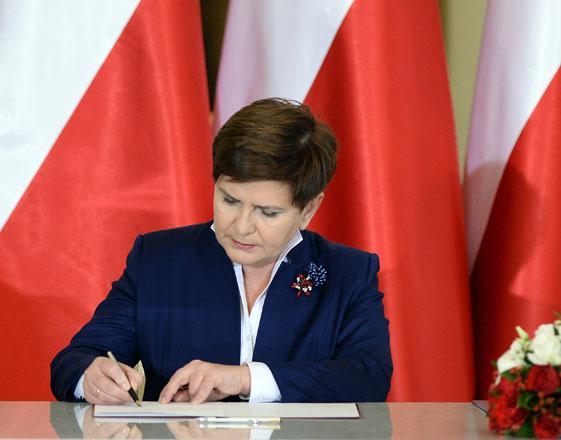You are here
Poland invites flood of ECB cash, risks exports
By Reuters - May 21,2015 - Last updated at May 21,2015
WARSAW — Cushioned by growth and facing elections, Poland is becoming an outlier in central Europe, where other countries are trying to curb the growing strength of their currencies in the face of the eurozone's massive money-printing plan.
Hungary, Romania and Serbia have all cut rates this year to prevent their currencies from gaining too much, as the European Central Bank's (ECB) programme feeds 60 billion euros a month into the continent's economy through September 2016.
The Czech Republic has put a cap on the value of the crown and pledged to intervene to keep it from rising
Poland, on the other hand, says it will not cut interest rates from the current 1.5 per cent, even though the zloty has risen nearly 7 per cent against the euro since the start of 2015, more than any other regional currency.
And with Polish bonds providing a significant yield premium over negative or rock-bottom euro yields, more cash is likely to flood in, barring a major flare-up in neighbouring Ukraine or a Greek exit from the eurozone.
"Poland is clearly more confident than its neighbours of sustaining relatively strong growth without a weaker currency," said Manik Narain, a strategist at UBS in London.
Indeed, all recent data show a recovering economy, which the government expects will grow at 3.4 per cent this year. While inflation is currently at minus 1.5 per cent, the government expects it to reach 1.7 per cent by next year. The housing market, at least in Warsaw, is robust.
What's more, presidential and parliamentary elections are due this year, and a strong currency plays well with voters enjoying cheaper vacations and imported goods, analysts note.
There are also 550,000 Poles holding mortgages denominated in Swiss francs. They saw monthly payments jump after January, when the Swiss central bank abandoned its cap on the franc. A weaker zloty would exacerbate their plight, probably to the detriment of the ruling Civic Platform.
"Poland has some of the strongest cyclical numbers in terms of industrial output and retail sales, plus there is the fact that Europe's economy continues to improve. This is causing them to hold back," said Koon Chow, investment strategist at Swiss private bank UBP.
A side effect of Poland's reluctance to curtail zloty appreciation is likely to be more investment flows from funds fleeing the euro zone's negative yields, Polish 5-year bonds yield a respectable 2 per cent-plus.
In fact, Poland's inflation-adjusted rate of 3 per cent is the highest among 23 big economies, bar Brazil and Nigeria, Reuters data shows.
Negative yields
The zloty jumped 1 per cent on Monday, approaching recent 3 1/2-year highs.
Chow reckons if the zloty appreciates further, Poland will have no choice but to follow its neighbours' lead and stem appreciation. A 25 basis points (bps) rate cut by mid-year is likely, he says.
So far, of all the countries struggling to contain their currencies, the Czech Republic has gone furthest. It cut interest rates to near zero in 2012, and in late 2013 declared it would keep the crown weaker than 27 per euro to ward off deflation.
However, the Czech economy was in recession in 2012 until early 2013. In contrast, Poland has grown robustly for the last 20 years. That makes deflation a far greater threat for Prague.
Hungary, meanwhile, resumed policy easing in March, cutting rates to a record-low 1.8 per cent and signaling more ahead. Government plans to cut Hungary's high banking tax show its intention to ask banks to increase lending, analysts say. That makes low interest rates a necessity.
Romania and Serbia have also cut rates and both have intervened in currency markets to tamp down the leu and dinar .
All that has taken some steam out of those currencies. The forint, for instance, is down about 1 per cent since the April 21 rate cut.
A key motivation, of course, is trade. Exports, mostly to the eurozone, accounted for 88 per cent of Hungary's annual economic output, World Bank data for 2013 showed. Czech exports were 77 per cent of gross domestic product (GDP).
Poland, by in contrast, with 40 million people, has a healthier domestic market, with exports comprising just 46 per cent of GDP.
Still, for some, central bankers' lack of concern is worrying, especially as the zloty's impact is already being felt among exporters. The exchange rate, currently 4 per euro, is just 3 per cent off 3.91. Beyond that level, companies say, exports become unprofitable..
And business sentiment has worsened this year, with the zloty's appreciation and falling prices having "negatively affected sales margins, both export and domestic ones", according to a central bank poll, which also predicted "relatively low exports dynamics" ahead.
At less than 4 zloty to the euro, "exporters will be in a difficult situation," Chow said. "Also, you can't assume European growth will remain firm. It's not an environment where monetary conditions should be tight."
Many will agree. Analysts polled by Reuters see one chance in four that policymakers would intervene to weaken the zloty this year. But that is probably some way off.
"We probably need to see zloty closer to 3.9 before they take a more activist approach," Narain of UBS said.
Related Articles
WARSAW — Poland's new right-wing, eurosceptic government was sworn in Monday signalling it would take a hard line on Europe's biggest migran
Damir Hajduk likens paying off his mortgage to the tale of Sisyphus in Greek mythology, condemned forever to push a boulder uphill, only for it to roll back down again and again.
WARSAW — Several countries have started to cut the amount of beef they import from Poland after a TV documentary showed an abattoir killing

















